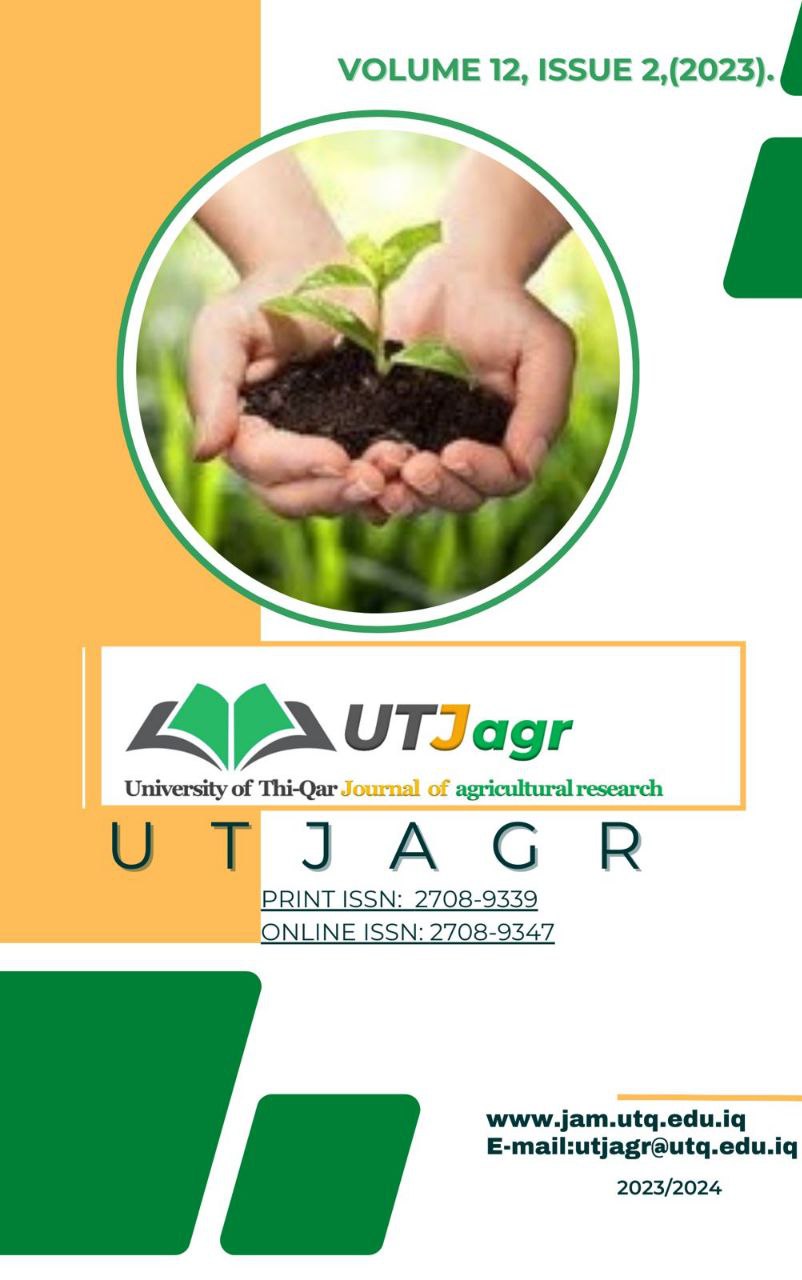First report of Fusarium subglutinans (Wollenw. & Reinking) (1983) as a causative agent of leaf spot disease on broad bean Vicia faba L. in Iraq
DOI:
https://doi.org/10.54174/utjagr.v12i2.259Keywords:
broad bean, Fusarium subglutinans ITS, molecular diagnosis phenotypicAbstract
Broad bean (Vicia faba L.) is one of the most common vegetable crops in Iraq; cultivated in many areas. Broad bean production has been affected significantly by several diseases caused by either bacteria or fungi; among these pathogens Fusarium have a direct impact on faba beans production. The current study was conducted at the laboratories of the College of Agriculture - University of Basrah to identify the fungal pathogens of broad bean leaf spot disease. Isolation of the fungal pathogen was performed on PDA and PCA media; the morphological and microscopic identification revealed the identity of Fusarium subglutinans, followed a molecular diagnosis by ITS universal primers (ITS1 and ITS4) with a similarity percentage of 99%; the gene sequence was deposited at NCBI as LC769974.
Experimental tests confirmed the pathogen's capability to infect the vegetative system of the broad bean plants. This is the first recorded of F. subglutinans being identified as the cause of leaf spotting on broad bean plants, making it a notable discovery in both Iraq and globally.
Downloads
References
Ahmed, A. N., & Abass, M. H. (2022). Disease Note: First Report of Cladosporium ramotenellum Schub., Zalar, Crous & Braun, 2007 (Fungi: Dothideomycetes) as a Potential Contaminant of Date Palm Tissue Culture. Basrah Journal of Agricultural Sciences, 35(2), 373-375
Arya, R. K.; Kumar, R.; Hooda, J. S.; Sutaliya, J.; Dahiya, M.;Vandana,G. S.; Raiger,H. L. ;Yadav, S. K.; Gill, R. K.; Mehto, J. L.; Tiwari, J. K.; Yadav, C. B.; Deen, M. K.; Punia,R. ; Raj,K.; Lal, R.; Kumar, P.; Tripathi, R. N.; Singh,G.; Singh,S. P.( 2022) Pre-breeding evaluation of germplasm for hybridization and screening of resulting transgressive elite genotypes faba bean for yield and its attributes for semi-arid regions of India. Ekin journal of crop breeding and genetics, 8(1) :17- 26
Borras, O., Santos, R., Matos, A. D., Cabral, R. S., & Arzola, M. (2001). A first attempt to use a Fusarium subglutinans culture filtrate for the selection of pineapple cultivars resistant to fusariose disease. Plant Breeding, 120(5), 435-438
Crépon, K., Marget, P., Peyronnet, C., Carrouee, B., Arese, P., Duc, G. (2010). Nutritional value of faba bean (Vicia faba l.) seeds for feed and food. Field Crops Research, 115 (3), 329–339.
Qahtan, A.A.; Al-Atar, A.; Abdel-Salam, E.M.; El-Sheikh, M.A.; Gaafar, A.-R.Z.; Faisal, M.(2021) Genetic diversity and structure analysis of a worldwide collection of faba bean (Vicia faba) genotypes using ISSR markers. International Journal of Agriculture And Biology, 25, 683–691
Han, K. S., Park, J. H., Back, C. G., & Park, M. J. (2015). First report of Fusarium subglutinans causing leaf spot disease on Cymbidium orchids in Korea. Mycobiology, 43(3), 343-346
Harish, J., Jambhulkar, P. P., Bajpai, R., Arya, M., Babele, P. K., Chaturvedi, S. K., ... & Lakshman, D. K. (2023). Morphological characterization, pathogenicity screening, and molecular identification of Fusarium spp. isolates causing post-flowering stalk rot in maize. Frontiers in Microbiology, 14, 1121781
Ichikawa K., Aoki T. 2000. New leaf spot disease of Cymbidium species caused by Fusarium subglutinans and Fusarium proliferatum. Journal of General Plant Pathology 66 (3): 213–218
Martineau-Côté, D., Achouri, A., Karboune, S., & L’Hocine, L. (2022). Faba bean: an untapped source of quality plant proteins and bioactives. Nutrients, 14(8), 1541
Shin, J. H., Han, J. H., Lee, J. K., & Kim, K. S. (2014). Characterization of the maize stalk rot pathogens Fusarium subglutinans and F. temperatum and the effect of fungicides on their mycelial growth and colony formation. The plant pathology journal, 30(4), 397
Hussein Abbas Jebur. (2023). A review: Machine relationship with the tractor and its effect on the productivity and compaction of agricultural soil. University of Thi-Qar Journal of Agricultural Research, 12(1), 22–43. https://doi.org/10.54174/utjagr.v12i1.237
Yaser, H. S., & Abass, M. H. (2022). Morphological and molecular identification study of rose and lantana fungal leaf spot pathogens. Basrah Journal of Science, 40(2), 342-356
Muhsin N. Hoshan, & Muhammad M. Yassin. (2023). The interaction effect of leaching requirements, salinity of irrigation water, levels of added sulfur and type of organic matter on soil salinity cultivated with maize plants (Zea mays L.) . University of Thi-Qar Journal of Agricultural Research, 12(1), 1–21. https://doi.org/10.54174/utjagr.v12i1.228

Downloads
Published
Issue
Section
License
Copyright (c) 2023 Baidaa G. Ofi, Mohammed H. Abass, Yehya A. Salih

This work is licensed under a Creative Commons Attribution-NonCommercial-ShareAlike 4.0 International License.







1.png)

